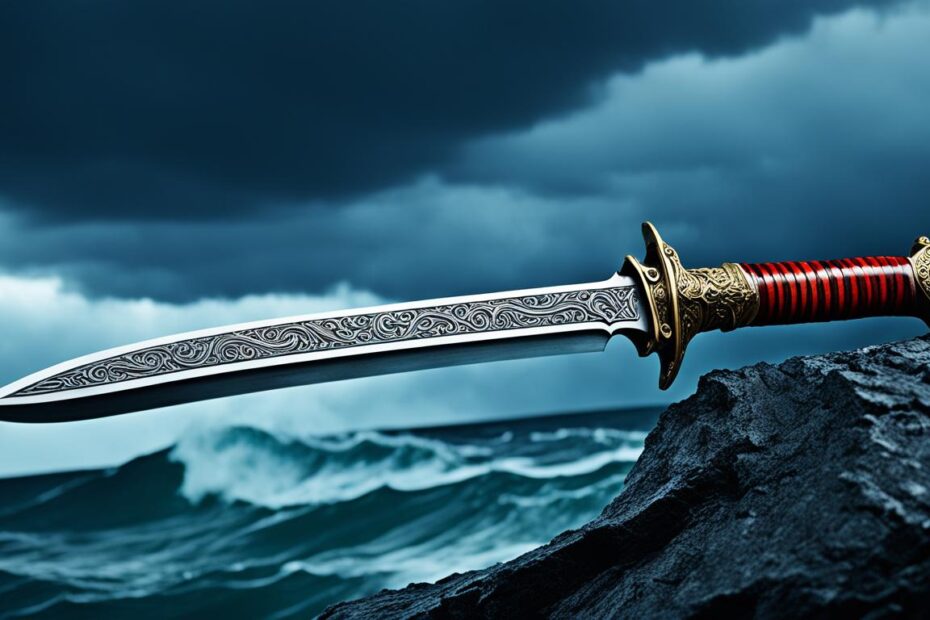Welcome to an exploration of the exquisite world of the Sansibar. This legendary sword, with its origins rooted in history, represents the pinnacle of tradition, craftsmanship, elegance, and unrivaled beauty.
Throughout the ages, the Sansibar has captured the imaginations of enthusiasts worldwide. Its rich legacy and cultural significance make it an iconic symbol of Filipino heritage. As we delve into the captivating history, meticulous craftsmanship, and enduring legacy of the Sword Sansibar, prepare to be transported to a bygone era, where honor, skill, and artistry merged effortlessly.
Join us as we embark on a journey through time, unearthing the secrets of its creation, exploring the symbolic importance it holds, and delving into the craftsmanship that has made it a masterpiece in the art of sword-making. Discover the allure of the Sansibar and immerse yourself in its captivating story.
Whether you are an avid collector, a history enthusiast, or simply curious about the cultural heritage of the Philippines, this in-depth exploration of the Sword Sansibar promises to captivate and inspire. So, let us embark on this journey to uncover the rich tapestry of tradition, craftsmanship, elegance, and history that defines the Sansibar.
The History of Sword Sansibar

In this section, we will take a deep dive into the captivating history of the Sword Sansibar. Originating from the Philippines, the Sword Sansibar holds a significant place among traditional Filipino weapons. Its evolution over time has solidified its status as an iconic symbol in Filipino culture.
The roots of the Sword Sansibar can be traced back to the 18th century, when Filipino warriors relied on it for its strength, versatility, and craftsmanship. The Sansibar was primarily used for close combat, enabling warriors to defend themselves against adversaries with skill and precision.
“The Sword Sansibar played a pivotal role in Filipino martial arts, showcasing the ingenuity and artistry of our ancestors. It became an extension of their prowess and identity,” says Antonio Dela Cruz, a renowned historian specializing in Filipino weaponry.
Over the years, the Sword Sansibar underwent various transformations, adapting to the needs of different eras. The weapon’s unique design, characterized by a straight, single-edged blade and a distinctive hilt, evolved to prioritize functionality while still reflecting the rich cultural heritage of the Filipino people.
During the Spanish colonization of the Philippines, the Sword Sansibar gained prominence as a symbol of resistance against foreign rule. It became a potent weapon in the hands of freedom fighters, serving as a reminder of the indomitable spirit of the Filipino people who yearned for independence.
As time progressed, the Sword Sansibar transcended its function as a weapon and became a treasured artifact, embodying the historical legacy and cultural traditions of the Philippines. Today, it is revered as a symbol of national identity, with exhibitions and museums showcasing the craftsmanship and significance of the Sword Sansibar.
Significance of Filipino Weapons
The Filipino archipelago holds a rich tradition of weapons that embody the spirit, history, and ingenuity of its people. Filipino weapons, including the Sword Sansibar, are not merely instruments of war, but cultural symbols that highlight the skills, values, and resilience of the Filipino warriors.
These weapons are a testament to the artistry and craftsmanship of Filipino swordsmiths who meticulously forged each blade, infusing it with history and meaning. From the intricately designed hilts to the razor-sharp blades, Filipino weaponry reflects the pride and dedication of the craftsmen who preserved and passed down these traditions through generations.
Furthermore, Filipino weapons represent the unique martial arts techniques and strategies developed by Filipino warriors. These fighting styles, such as Eskrima, Kali, and Arnis, emphasize adaptability, speed, and precision. The Sword Sansibar, as a key component of these martial arts, seamlessly merges form and function, embodying the Filipino warrior’s spirit.
| Key Points: | Notable Quotes: |
|---|---|
| – The Sword Sansibar holds a significant place among traditional Filipino weapons. | “The Sword Sansibar played a pivotal role in Filipino martial arts, showcasing the ingenuity and artistry of our ancestors. It became an extension of their prowess and identity,” says Antonio Dela Cruz, a renowned historian specializing in Filipino weaponry. |
| – The Sword Sansibar evolved over time, reflecting the rich cultural heritage of the Filipino people. | |
| – It became a symbol of resistance against foreign rule during the Spanish colonization of the Philippines. | |
| – The Sword Sansibar is revered as a national symbol and showcased in exhibitions and museums. |
The Craftsmanship of Sword Sansibar
When it comes to the Sword Sansibar, it is not just a weapon of beauty and strength, but a masterpiece of craftsmanship. The creation of a Sword Sansibar involves traditional sword-making techniques that have been honed and passed down through generations.
At the heart of the Sword Sansibar is the skill and expertise of the craftsmen who dedicate themselves to preserving the art form. They meticulously transform raw materials into a work of art, paying close attention to every detail.
Traditional sword-making techniques are employed, ensuring that each Sword Sansibar is crafted with precision and care. These techniques involve a combination of forging, tempering, and finishing processes that require the utmost skill and knowledge.
During the forging process, the blade is meticulously shaped and hammered to create its distinctive curve and blade geometry. The craftsmen use their expertise to achieve the perfect balance between strength and flexibility.
After forging, the blade undergoes a tempering process to enhance its hardness and resilience. This involves heating the blade to a specific temperature and then rapidly cooling it, resulting in a hardened edge and a durable blade.
Once the tempering process is complete, the craftsmen apply various finishing techniques to give the Sword Sansibar its final form. This includes polishing the blade to achieve a mirror-like finish, carefully etching intricate designs, and adding decorative elements that showcase the artistry of the craftsmen.
The craftsmanship of the Sword Sansibar is a labor of love and dedication. It is a testament to the skill and artistry of the craftsmen who keep the tradition alive. Each Sword Sansibar crafted with these traditional techniques is a unique and timeless masterpiece, representing the rich cultural heritage of the Philippines.
| Traditional Sword-Making Techniques | Craftsmanship of Sword Sansibar |
|---|---|
| Forging | Meticulously shaping and hammering the blade to create its distinctive curve and blade geometry |
| Tempering | Heating the blade to a specific temperature and rapidly cooling it to enhance its hardness and resilience |
| Finishing | Polishing the blade, etching intricate designs, and adding decorative elements to achieve a stunning and unique Sword Sansibar |
The Legacy of Sword Sansibar
The Sword Sansibar holds a significant place in history and serves as a testament to the rich cultural heritage of the Filipino people. Its legacy extends beyond being a weapon; it represents the resilience, skill, and craftsmanship of its creators.
Throughout the years, the Sword Sansibar has remained a cherished symbol of Filipino identity and tradition. Its significance lies not only in its practical use as a weapon but also in its role as a cultural artifact. Passed down through generations, the Sword Sansibar embodies the cultural heritage of the Filipino people, serving as a tangible link to their ancestors and their history.
Today, the legacy of the Sword Sansibar continues to be celebrated and preserved. It holds a special place in museums, galleries, and private collections around the world, where its historical and cultural significance is recognized. The craftsmanship behind each Sword Sansibar is admired, showcasing the intricate details and skillful techniques employed by Filipino artisans. As a symbol of tradition and elegance, the Sword Sansibar has become an iconic piece of Filipino heritage.
